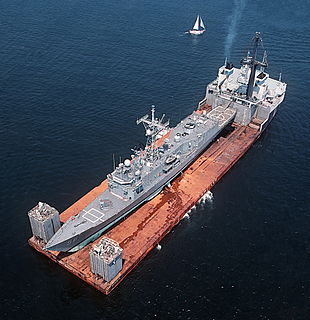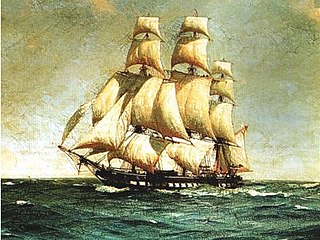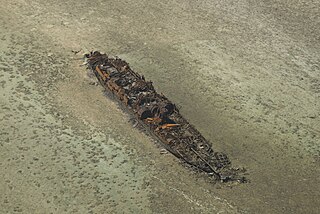 W
WThis is a list of shipwrecks in the Indian Ocean.
 W
WMS Achille Lauro was a cruise ship based in Naples, Italy. Built between 1939 and 1947 as MS Willem Ruys, a passenger liner for the Rotterdamsche Lloyd, she was hijacked by members of the Palestine Liberation Front in 1985.
 W
WThe Belitung shipwreck is the wreck of an Arabian dhow which sank en route from Africa to China around 830 CE. The ship completed the outward journey, but sank on the return journey, approximately 1 mile (1.6 km) off the coast of Belitung Island, Indonesia. It is unclear why the ship was so far from its expected route back from China. Belitung is to the south-east of the Singapore Strait by 380 miles (610 km), and this secondary route is more normal for ships travelling from the Java Sea, which is south of Belitung Island.
 W
WHMS Brilliant was a 36-gun Venus-class fifth-rate frigate of the British Royal Navy that saw active service during the Seven Years' War with France. She performed well against the French Navy in the 1760 Battle of Bishops Court and the 1761 Battle of Cape Finisterre, but was less capable when deployed for bombardment duty off enemy ports. She also captured eight French privateers and sank two more during her six years at sea. The Royal Navy decommissioned Brilliant in 1763. The Navy sold her in 1776 and she became an East Indiaman for the British East India Company (EIC). Brilliant was wrecked in August 1782 on the Comoro Islands while transporting troops to India.
 W
WCleopatra was a Victorian-era wooden paddle steam frigate of the East India Company. Constructed at Northfleet, the ship arrived at Bombay on 19 April 1840, and operated as a transport and mail steamer between Bombay to Karachi, Aden and Suez.
 W
WUSS Concord was a wooden-hulled, three-masted sloop-of-war of the United States Navy and was launched on 24 September 1828 from the Portsmouth Naval Shipyard in Kittery, Maine. She was the first US Navy vessel to bear the name 'Concord' and was so named after the town of Concord for its role at the beginning of the American Revolution. The vessel had a tonnage of 700. The Concord had a complement of 190 officers and seamen with an armament of 20 guns and saw service protecting American merchant ships and other interests in several places around the world. The ship and her crew, who also functioned as Marines, fought in the Seminole Wars in Florida. Concord ran aground while on a patrolling mission along the African coast. Despite determined efforts from the crew, with three losing their lives in the process, the Concord was unable to be refloated. It was the first ship christened by a woman. Sloop-of-war Concord, launched in 1827, was "christened by a young lady of Portsmouth." This is the first known instance of a woman sponsoring a United States Navy vessel. Unfortunately, the contemporary account does not name this pioneer female sponsor.
 W
WCorona was a 40-gun Pallas-class frigate of the Italian Navy. The French built her in Venice in 1807 for the Napoleonic Kingdom of Italy. The British captured Corona at the Battle of Lissa and took her into the Royal Navy as HMS Daedalus. She grounded and sank off Ceylon in 1813 while escorting a convoy.
 W
WCorona was a 40-gun Pallas-class frigate of the Italian Navy. The French built her in Venice in 1807 for the Napoleonic Kingdom of Italy. The British captured Corona at the Battle of Lissa and took her into the Royal Navy as HMS Daedalus. She grounded and sank off Ceylon in 1813 while escorting a convoy.
 W
WUSS Epperson (DD/DDE-719) was a Gearing-class destroyer of the United States Navy. It was named for United States Marine Corps Private Harold G. Epperson (1923–1944) who was posthumously awarded the Medal of Honor for his heroism in the Battle of Saipan.
 W
WFrontier was a 1,000 GRT cargo ship that was built in 1922 as Cattaro by Memeler Schiffswerke, Lindenau & Co, Memel, Germany. After a sale in 1930 she was renamed Finkenau. In 1945, she was renamed Levensau and was seized later that year by the Allies at Brunsbüttel, passed to the Ministry of War Transport (MoWT) and was renamed Empire Convoy. She was allocated to the Netherlands in 1946 and renamed Grebburg. She was sold into merchant service in 1947 and renamed Echo. A sale to South Africa in 1952 saw her renamed Frontier. The ship served until 1957 when she ran aground and broke up.
 W
WHMS Sibyl was a 28-gun Enterprise-class sixth-rate frigate of the Royal Navy. Sibyl was renamed HMS Garland in 1795.
 W
WHis Highness' Ship Glasgow was a royal yacht belonging to the Sultan of Zanzibar. She was built in the style of the British frigate HMS Glasgow which had visited the Sultan in 1873. Glasgow cost the Sultan £32,735 and contained several luxury features but failed to impress the Sultan and she lay at anchor in harbour at Zanzibar Town for much of her career. The vessel was brought out of semi-retirement on 25 August 1896 when she participated in the Anglo-Zanzibar War and was soon sunk by a flotilla of British warships. Glasgow's wreck remained in the harbour, her three masts and funnel projecting from the water, until 1912 when she was broken up for scrap.
 W
WThe Great Basses wreck is an early 18th-century shipwreck on Great Basses Reef, about 12 km off the south coast of Sri Lanka, discovered by Arthur C. Clarke and Mike Wilson in 1961. The ship, ultimately identified as belonging to the Mughal Emperor Aurangzeb, yielded fused bags of silver rupees, cannons, and other artifacts. The discovery was carefully documented and became the basis for Clarke's 1964 book The Treasure of the Great Reef.
 W
WJamnagar was a 576 GRT coaster which was built in 1924 for Maharaja Jam Sahib of Nawanagar. In 1941 she entered service with the Royal Indian Navy. In 1944, she was sold into merchant service before being requisitioned by the Ministry of War Transport (MoWT) and renamed Empire Bulbul. In 1947, she was sold into merchant service and renamed Hellenic Bulbul. The name Hellenic Bee had been allocated but she ran aground and sank before the proposed name change could be implemented.
 W
WSS Koning der Nederlanden was a Dutch ocean liner of the Netherland Line. She served from 1872 until her sinking in 1881 in the Indian Ocean while en route from Batavia to Amsterdam. Three of her lifeboats, with a total of 90 passengers and crew, were never found.
 W
WLapérouse was a cruiser of the French Navy, lead ship of her class, named after Jean-François de Galaup, comte de Lapérouse.
 W
WLord Nelson was an East Indiaman, launched in late 1799, sailing for the East India Company. She made five voyages, of which she completed four. On her second voyage the French privateer Bellone captured her, but the Royal Navy recaptured her within about two weeks. On her fifth voyage, Lord Nelson foundered in 1808 with the loss of all aboard.
 W
WMagicienne was a frigate of the French Navy, lead ship of her class. The British captured her in 1781 and she served with the Royal Navy until her crew burned her in 1810 to prevent her capture after she grounded at Isle de France. During her service with the Royal Navy she captured several privateers and participated in the Battle of San Domingo.
 W
WHMS Megaera was originally constructed as an iron screw frigate for the Royal Navy, and was one of the last and largest ships built by William Fairbairn's Millwall shipyard.
 W
WMighty Servant 2 was a 29,000-ton semi-submersible, heavy-lift ship operated by Dockwise. The ship drew worldwide attention in 1988 for transporting the mine-damaged USS Samuel B. Roberts from Dubai to Newport, Rhode Island.
 W
WMOL Comfort was a 2008-built Bahamian-flagged post-Panamax container ship chartered by Mitsui O.S.K. Lines. The vessel was launched in 2008 as APL Russia and sailed under that name until 2012, when the ship was renamed to MOL Comfort. On 17 June 2013, she broke in two about 200 nautical miles off the coast of Yemen. The aft section sank on 27 June and the bow section, after having been destroyed by fire, on 11 July.
 W
WMTS Oceanos was a French-built and Greek-owned cruise ship that sank in 1991 due to uncontrolled flooding. Her captain and some of the crew were convicted of negligence for fleeing the ship without helping the passengers, who were subsequently rescued thanks to the efforts of the ship's entertainers.
 W
WThe Preneuse was a 44-gun frigate of the French Navy, lead ship of her class. She served as a commerce raider at Île de France.
 W
WRandolph was a 664-ton ship-rigged merchant vessel constructed in 1849 in Sunderland. She was one of the First Four Ships to settle Christchurch, New Zealand.
 W
WHMS Sappho was a Royal Navy brig that gained public notoriety for causing a diplomatic incident over the slave trade with the United States of America and then went missing off the Australian coast in 1857–58.
 W
WSensible was a 32-gun Magicienne-class frigate of the French Navy. The Royal Navy captured her in 1798 off Malta and took into service as HMS Sensible. She was lost in a grounding off Ceylon in 1802.
 W
WHMS Serapis was a Royal Navy two-decked, Roebuck-class fifth rate. Randall & Brent built her at Greenland South Dockyard, Rotherhithe and launched her in 1779. She was armed with 44 guns. Serapis was named after the god Serapis in Greek and Egyptian mythology. The Americans captured her during the American War of Independence. They transferred her to the French, who commissioned her as a privateer. She was lost off Madagascar in 1781 to a fire.
 W
WHMS Sibyl was a 28-gun Enterprise-class sixth-rate frigate of the Royal Navy. Sibyl was renamed HMS Garland in 1795.
 W
WHMS Sirius was a 36-gun fifth-rate frigate of the Royal Navy. Between 1797 and 1805, the Sirius was engaged in maintaining the blockade of Napoleonic Europe. She was lost in 1810 when her crew scuttled her after she grounded during the Battle of Grand Port.
 W
WMS Skaubryn was a Norwegian passenger ship launched in 1950, which sailed between Europe and Australia. She sank in the Indian Ocean in April 1958, after a fire.
 W
WSpice Islander I was a 836 GRT Ro-Ro ferry which was built in Greece in 1967 as Marianna. She was renamed Apostolos P following a sale in 1988. She was sold to a Honduran company in 2007 and renamed Spice Islander I. On 10 September 2011, she sank resulting in the deaths of 1,573 people; many of whom were never recovered.
 W
WSunny South, an extreme clipper, was the only full-sized sailing ship built by George Steers, and resembled his famous sailing yacht America, with long sharp entrance lines and a slightly concave bow. Initially, she sailed in the California and Brazil trades. Sold in 1859 and renamed Emanuela, she was considered to be the fastest slaver sailing out of Havana. The British Royal Navy captured Emanuela off the coast of Africa in 1860 with over 800 slaves aboard. The Royal Navy purchased her as a prize and converted her into a Royal Navy store ship, Enchantress. She was wrecked in the Mozambique Channel in 1861.
 W
WTaitsing was a famous British tea clipper.
 W
WSS Tottenham was a British ship, that ran onto the southern fringing reef of Juan de Nova Island in 1911. Its wreck can still be found there.
 W
WRIMS Warren Hastings was a Royal Indian Marine troopship built by the Barrow Shipbuilding Company. She was launched on 18 April 1893, and claimed to be "practically unsinkable" because of her 33 watertight compartments. However, whilst in service the ship struck a rock and was wrecked off the coast of Réunion on the night of 14 January 1897, while travelling to Mauritius from Cape Town. The wreck resulted in two deaths.